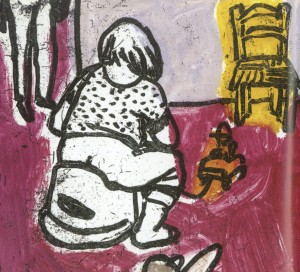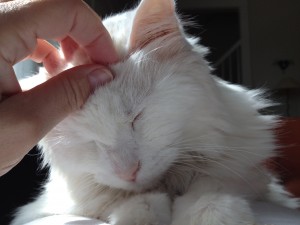Seat & Feet
 Here’s a tip I brought back from one of Eric Kolvig‘s talks at the Tucson retreat:
Here’s a tip I brought back from one of Eric Kolvig‘s talks at the Tucson retreat:
Periodically throughout the day, especially when things start to escalate, see if you can bring your attention to your “seat” (the sensations of your butt on the chair, if you’re sitting) and/or to your feet. This offers a chance to get out of the whirlwind of whatever’s going on for a second and helps to ground you in the present moment. It doesn’t change anything about what’s going on. Except that it interrupts the habitual reactions we often get hooked into…which, of course, does give us the chance to take a fresh look at the situation and maybe respond more skillfully this time.
Give it a try!
(image: from “A Whole World,” by Couprie and Louchard)
Would You Like Some?
 On my way to the retreat in Arizona, I was flying from Phoenix to Tucson, after having flown from St. Louis to Phoenix. It was late in the day, and I was hungry, but I definitely wasn’t going to buy any of the unhealthy, overpriced snacks the flight attendant was selling…and then I saw the little can of Pringles, and the desire for that exact combination of salt and fat and starch arose in my mind…along with the certainty that it would be the perfect thing to go with the Diet Coke I was already drinking….so I bought them. I paid three dollars for that little can! Which irritated me. But there I was…hungry and captive. I wanted those Pringles! So I got them.
On my way to the retreat in Arizona, I was flying from Phoenix to Tucson, after having flown from St. Louis to Phoenix. It was late in the day, and I was hungry, but I definitely wasn’t going to buy any of the unhealthy, overpriced snacks the flight attendant was selling…and then I saw the little can of Pringles, and the desire for that exact combination of salt and fat and starch arose in my mind…along with the certainty that it would be the perfect thing to go with the Diet Coke I was already drinking….so I bought them. I paid three dollars for that little can! Which irritated me. But there I was…hungry and captive. I wanted those Pringles! So I got them.
And then the thought arose, that the woman sitting next to me, who was also drinking a Diet Coke, might like to have some too.
But I had paid THREE DOLLARS for that little can.
And I was hungry.
And I wanted to eat them. All of them.
So I opened the can and started eating.
They were good. But I felt bad about not sharing. It wasn’t that I felt like I should have shared them. Or that I was somehow a bad person for not doing it. In the past, in never would have occurred to me to share what I was eating on a plane. I certainly wouldn’t have expected anyone sitting next to me to share what they were eating!
But, still, I couldn’t let go of the feeling that the woman sitting next to me….who was traveling late in the day (like me), and drinking a Diet Coke (like me)…must surely want some Pringles (just like me!)
So I offered her some.
Turns out, she didn’t want any. But she was certainly pleased — and surprised — that I had offered.
And I felt great.
Much, much better, in fact, than I had before I’d offered them.
The Pringles were good.
But this was WAY better.
I’ve heard that ethical behavior leads to the bliss of blamelessness. This was a feeling I can only describe as the joy of generosity. More accurately, it’s the happiness that comes from realizing that we’re not all that different…or separate…from each other.
Try it.
(image: this is another one of those cards that I’ve had forever and don’t know where they came from…or who to credit)
Ready for Your Close-Up?
 The third Ego-Renunciation Practice that the “Dancing with Life” KM group will be playing with over the next couple of weeks is: giving up being the star of your own movie.
The third Ego-Renunciation Practice that the “Dancing with Life” KM group will be playing with over the next couple of weeks is: giving up being the star of your own movie.
In Dancing with Life, Phillip Moffitt writes, “The unfolding of events that make up your life is like a movie, is it not? And you interpret every scene or event from the vantage point of being the star of your movie–is it good or bad for you, do you like it or not, and so on.
“Once you renounce being the star of your own movie, you begin to see the unfolding of each scene and the movie as a whole from multiple perspectives. You don’t forsake your role in the movie, but once you cease making it be all about you, the movie creates less anxiety and you are more able to live from your core values.”
Give it a try!
(image: Steampunk Tarot by Curly Cue Design)
How Much is Enough?
 The second Ego-Renunciation Practice in Dancing with Life is committing to no longer measuring the success of your life by how many of your wants are met.
The second Ego-Renunciation Practice in Dancing with Life is committing to no longer measuring the success of your life by how many of your wants are met.
Phillip Moffitt writes, “This renunciation allows you to still have desires, but they’re not at the center of your life. You fulfill those wants that can be fulfilled while living from your deepest values, and you slowly abandon the rest.
“This means that your sexual desires are constrained by non-harming, material gains are limited by ethical and generous behavior, and your ego need for achievement and attention is less of a priority than living according to your core values. Of course you still have to fulfill your basic needs and live up to your responsibilities as best you can, but you renounce measuring success by what you have and what you have achieved.
“You many be surprised to discover how much you have been judging your life by this standard. It is so common that it is almost entirely unconscious, and it is devastating to inner growth because the ego can always distract you with another want.”
(image: Kitty Kahane Tarot)
But I Like Being Right!
 The Monday night “Dancing with Life” KM group has decided to try out the Three Ego-Renunciation Practices Phillip Moffitt describes in Chapter 11 (of Dancing with Life: Buddhist Insights for Finding Meaning and Joy in the Face of Suffering). He suggests these practices as a way to “directly challenge your ego’s desire to always be in charge.” They are particularly helpful for modern practitioners because they “loosen the ego’s grasp on the mind but don’t require you to make any outward changes in your life.”
The Monday night “Dancing with Life” KM group has decided to try out the Three Ego-Renunciation Practices Phillip Moffitt describes in Chapter 11 (of Dancing with Life: Buddhist Insights for Finding Meaning and Joy in the Face of Suffering). He suggests these practices as a way to “directly challenge your ego’s desire to always be in charge.” They are particularly helpful for modern practitioners because they “loosen the ego’s grasp on the mind but don’t require you to make any outward changes in your life.”
The first practice is: Renouncing Your Attachment to Being Right
“Most of us cling to the need to be right, and making this renunciation can dramatically affect both how you interact with others and how you interpret events. When the renunciation starts to be real, you have a much easier time making decisions and have less of a need to position yourself with others or in your own mind.
“Giving up always being right doesn’t mean you forsake your opinions or your right to seek social justice, but you are not defensive, judgmental, or self-righteous in your approach to life.
“You mindfully live with the fact that even when you’re wrong, it’s okay because you are coming from your deepest intention. Also, you learn from being wrong (or right), therefore you become a more effective person.”
Give it a try!
I’ll post the second and third practices in the Friday and Monday posts. Stay tuned.
(image: Witch Tarot)
People Who Practice Metta….
 At the Metta Retreat I sat with Sylvia Boorstein many years ago, she told a story about learning the practice from Sharon Salzberg. The first thing Sharon had her do was to memorize the traditional “Benefits of Metta” which goes like this:
At the Metta Retreat I sat with Sylvia Boorstein many years ago, she told a story about learning the practice from Sharon Salzberg. The first thing Sharon had her do was to memorize the traditional “Benefits of Metta” which goes like this:
People who practice Metta,
Sleep peacefully,
Wake peacefully,
Dream peaceful dreams.
People love them,
Angels love them,
Angels will protect them.
Poisons and weapons and fire don’t harm them.
Their faces are clear.
Their minds are serene.
They die unconfused.
And when they die, their rebirth is in heavenly realms.
At the retreat, Sylvia had each of us consider which of these benefits we most wanted for ourselves. If she had asked us to say publicly which one we had chosen, I probably would have said: “their minds are serene.” But the truth is, I really wanted: “people love them.” I smile when I think of that now, but back then I had the idea that since I didn’t have a romantic partner, I didn’t have love.
I have been practicing Metta for several years, and I guess you could say it has “worked,” because although I still don’t have a romantic partner, I certainly don’t feel that I don’t have love.
Maplewood Metta meets tonight and every Tuesday night. It’s a small group, but very, very sweet. We read the Metta Sutta, then sit for 30 minutes, then share whatever is on our mind. It’s really a pleasure and I’d love for more people to attend.
Where: Jon Yaffe’s house in Maplewood. Contact him here for the address.
When: Every Tuesday, 6:30 to 7:30 pm
I hope to see you there.
(image: Q-cards)
Why Do We Meditate?
 In reading the transcript of Christina Feldman‘s talk on Dependent Co-Arising (for the DPP homework assignment), I was struck by her comments on the paradox of meditation, which is that we practice “being with what is,” but we do it in order to develop greater peace, clarity, compassion and wisdom. (Which sounds like we’re trying to find something better than what is.)
In reading the transcript of Christina Feldman‘s talk on Dependent Co-Arising (for the DPP homework assignment), I was struck by her comments on the paradox of meditation, which is that we practice “being with what is,” but we do it in order to develop greater peace, clarity, compassion and wisdom. (Which sounds like we’re trying to find something better than what is.)
Here’s what she says, “This is actually an interesting paradox because it straddles a very fine line. One part of meditation, for example, is the capacity to be in harmony with what is. At the same time, there’s a visionary part in every spiritual practice which is about what is possible. Holding these two together is the challenge of the practice; being with what is through our meditation training, we need to separate from any sense of resignation or passivity.
“Positively, being with what is means seeing the true nature of what’s happening in the moment — it is arising, it is passing, it has its own flavor, etc. On the other hand, knowing what is possible means giving attention to our own capacities for awareness and wisdom, and having the clarity to hold what is happening in the light of wisdom. That’s the visionary part.
“So it’s not about changing the world; it’s not about changing myself into a more enlightened self. It is about the sense of trusting the vision that freedom, clarity and very deep and powerful levels of understanding are possible, that they begin and are born in what is within the field of our experience right now.
“We don’t meditate in order to stay the same. We don’t meditate in order to reject whatever is present in the moment. We meditate in order to find the possibility in the moment, first through seeing the capacity for freedom within that moment.”
(image: Phantasmagoric Theater Tarot)
What Would That Be Like?
 I’ve been spending a lot of time lately reading and listening to talks by Ajahn Sucitto. I especially like the meditation instructions he gives for metta (lovingkindness) meditation (from Kamma and the End of Kamma):
I’ve been spending a lot of time lately reading and listening to talks by Ajahn Sucitto. I especially like the meditation instructions he gives for metta (lovingkindness) meditation (from Kamma and the End of Kamma):
“We often begin a meditation period with recollections and checking in with our general state of being. What is needed is to develop a sense of befriending oneself, establishing an attitude which is non-judgemental and interested in bringing some immediate well-being into one’s life. The most immediate way to bring this around is right here, on the spot where you are, through an applied attitude.
“Establish your presence in the place where you’re sitting, putting other concerns to one side. Then ask yourself, ‘How am I right now?‘ Repeat this slowly a few times and although the bodily sensations or mind-states may change, attend to the more continual overall feeling of what it’s like to be yourself.
“Then consider: ‘What would it be like if….I was in the presence of someone or something that was regarding me with warmth?‘ (You can even recollect your dog…or cat!) Introduce the thought ‘What would that be like? How would I sense that?’ and attend closely to any resonance in the heart.
“Recollect any time in your life when someone was glad to see you, did you a favor, gave you some kindly attention, or enjoyed your presence. ‘How is that, now?’ Then: ‘Does my body know that?’ Attend to any drop in tension, or lift in energy–particularly in the face, and in the heart region.
“Put aside more general reflections or memories of that person or that time, and return to the specific moment and how it felt for you. You may repeat this with a few people and several incidents.
“When you can establish that process, linger in the heart and bodily effect and lessen the thinking accordingly. Gradually simplify and consolidate that process until you arrive at a simple image (of warmth or light for example) or a bodily sense–of ease or joy. Sit with that, sweeping it through your body like a massage.
“As you settle into that, breathe it into your presence. Then expand it out through the skin into the space immediately around you. You may wish to express that benevolence to particular people, or to other beings in general.
“Then bring to mind someone whom you have no strong feelings for. Consider seeing them out of context in which you normally encounter them. Imagine them enjoying themselves, or worried, or in distress. Spend some time rounding out your impression of them in a sympathetic way. ‘May he/she be well.’ Expand your awareness of the feel of that wish; notice how it affects your overall disposition and body tone. Enjoy feeling more empathically attuned.”
(image: my cat, Elvis, and me)
For Your Reflection
 In yesterday’s post, I mentioned my fascination with the idea from Phillip Moffitt’s e-Teaching on The Search for Meaning that we might be co-creating the meaning of life.
In yesterday’s post, I mentioned my fascination with the idea from Phillip Moffitt’s e-Teaching on The Search for Meaning that we might be co-creating the meaning of life.
He goes on to discuss the role of doubt:
“Each of us has a small or large voice inside that says there is no meaning. It’s there in all of us. You don’t need to get that voice to go away; instead, bring it into consciousness. Say to yourself, ‘This is me not believing that anything matters, but that’s just thoughts. Not believing anything matters and there’s no meaning…feels like this.’
“Explore beliefs and trust that however you’re leaning, it doesn’t have to change your behavior. Not only can you tolerate your sense of what’s true for you, you know that it may change. It gives your ego the chance to look at itself and not be afraid.”
Phillip ends with this terrific list of questions which I offer for your reflection:
Do you know what you believe?
Do you believe there’s meaning or do you doubt it? Or, do you believe we’re co-inventing it as we go?
Is your behavior aligned with what you believe?
(image: Kiawah Island beach at sunset, New Year’s Eve)
Creating As We Go
 At the end of the year, I received the latest e-Teaching from Phillip Moffitt’s DharmaWisdom website. The subject was The Search for Meaning, which oddly enough, just sort of floated right over my head. Maybe it’s because I was in holiday overload, but I didn’t even open the email. I just let it sit there in my inbox along with miscellaneous year-end sales promotions, charity pleas and credit card offers.
At the end of the year, I received the latest e-Teaching from Phillip Moffitt’s DharmaWisdom website. The subject was The Search for Meaning, which oddly enough, just sort of floated right over my head. Maybe it’s because I was in holiday overload, but I didn’t even open the email. I just let it sit there in my inbox along with miscellaneous year-end sales promotions, charity pleas and credit card offers.
But then I read it, and it wasn’t the vague over-view that I guess I had been expecting. It contained an idea that I don’t think I’ve ever really considered: The possibility that there isn’t inherent meaning to life, but that there is meaning that we are somehow co-inventing….that we are creating the meaning of life as we go!
Here’s the part of the e-mail that really caught my attention:
“If you can truly commit to “don’t know mind,” you can explore this question of whether life has meaning in a purposeful way. I believe there are three possible truths.
“The first is that there is no meaning outside of our own experience, whether it’s pleasant or unpleasant. If there is no meaning other than the material moment, then our sense of a greater meaning is some combination of superstition and a way of coping with the existential fear of life’s certainties: We will die, we can’t control what happens to us while we’re alive, and we don’t know if there’s any purpose to our struggles and victories.
“The second possibility is that there is meaning to life that is outside the immediate experience. That meaning can be completely predestined, or there can be some room for us to participate in a small or large way, depending on what you believe.
“Lastly is the possibility that there isn’t inherent meaning but there is meaning that we are either co-inventing or inventing by ourselves, i.e. we’re creating the meaning as we go. Maybe we’ve been co-creating the meaning of life from the moment of the Big Bang.”
I find that possibility fascinating.
Check out Phillip’s DharmaWisdom website for more.
(image: me and the sea on Kiawah Island)
